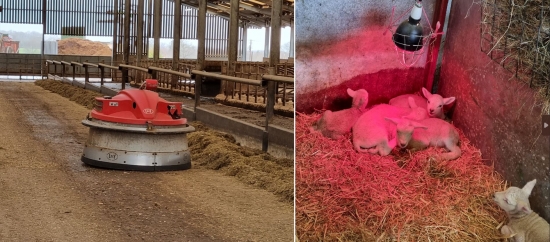Reports
Lambing time at Llysfasi
13 March 2024
We are standing in a chilly damp wind 265 metres up in the Clwydian Hills, looking down at the distant Llysfasi ‘campus’ over 100 m below. Despite the conditions we are totally engaged in listening to Dewi Wyn Jones, Farm Manager and Lecturer as he describes the land around us, all of which makes up the 400 hectares of Llysfasi. It is a proper working farm, paying its own way and facing all the issues farming encounters today. The 300 students therefore get a thorough training in what it takes to be part of our agricultural industry. The farm includes moorland where the mountain sheep roam, upland grazing for sheep and cattle and lowland grazing and arable land.
Llysfasi is one of six sites making up Coleg Cambria in North East Wales. We chose this time to visit because it is lambing season. The farm holds 650 sheep including Lleyn, Welsh Mountain and Welsh Mules. In the warmth and shelter of the lambing sheds the ewes are giving birth, the lambs are receiving their mother’s number, their tails are fitted with tight bands so that they will fall off in due course and the ram lambs are being castrated, again by fitting tight bands around the scrotum. Coloured disinfectant marks the lambs recently treated. Their mothers too are marked, not just with their ID number but also, following scanning during pregnancy with a colour denoting whether they are bearing twins or triplets. (For the ewe, and the student shepherds, twin lambs are the easiest. Their comparatively small size makes birth easier “even if they are the wrong way round” Dewi tells us. Triplets may require a little extra care and single lambs, being the biggest, are the ones which may require intervention. The general rule however is to leave things to the ewe. She will take her time. Early signs of impending labour are agitation by the ewe, ‘nest building’ and pawing the ground - also part of preparing the ground for giving birth. The sheep sheds are quiet places and everything is designed to give the ewes and lambs the best environment before they are turned out to graze. The ewes from lowland flocks here produce 1.8 lambs each on average. In the mountains the ratio is lower but still above one. The other statistic of note is that a ram will typically inseminate 50 ewes in the lowlands. In the hills the rams are freer to roam and cover many more ewes.
The cow sheds too are quiet. They are very well ventilated. (A cow, if kept dry, does not suffer from the cold until the air temperature falls below minus 10C, a rare event in this part of Wales.) The herd of 250 milking cows are pedigree Friesian/Holstein but there were some Montbéliarde too, with their unusual ‘pink’ and white colouration. Two aspects were particularly interesting: the milking parlour and the robot in charge of tidying the feed. The latter normally sits quietly at its electrical recharge point but then sets off down the line of feeding cows, safely at the head end where the cattle are feeding on a line of silage etc. As they feed they inevitably disturb the arrangement and push some of the feed out into the hardstanding, beyond their reach. This is where the robot comes in. Without human intervention (being already programmed) it gently pushes the feed back towards the cattle and leaves everything tidy. In a dairy context, it is the production of additional milk that is the main benefit of the additional feed intake associated with the use of the robot, although maintaining body condition in early lactation and its recovery in later lactation are also potential benefits. Metal strips inform the robot when to turn at the end of the row, to cross the barn to the next row of untidy feed, work its way along and eventually turn in to its charging point. Fascinating!
The milking parlour is something else! Twenty cows will be lined up feeding and being milked in a line on the right while another twenty are moving into position on the left. The sequence is: hose down the raised walkway beside the lower level where the staff work; the cows walk in to the furthest available feeding station; students then clean the teats and fit the suction cups to each cow. After milking the cows again leave in a sedate, orderly fashion, passing through a foot bath on their way out. The heat of the animals made a nice change from the chill outside but in the summer the huge parlour is fitted with large fans and very fine mists of water to keep the temperature comfortable for cows and humans.
Hygiene, safety and the needs of animal welfare are paramount. The farm is almost self-contained but may import animal feed and therefore inevitably bring onto the farm nutrients like phosphate. Disease is always a threat but monitoring and good husbandry minimise the impact. Carbon footprint and energy efficiency are also top of the agenda and we learned how in cooling the milk the heat extracted is made full use of on the farm. They don’t yet have biogas fermenters but there is a ready supply of the raw materials for methane production available for the future.
We spent three hours totally enthralled by the detail generously provided. We only wish that more members had been able to share this experience. You missed a treat!
John Solbé MBE CBiol FRSB
River Restoration in Action
1 March 2023
The catchment of the river Dee is large by UK standards, over 1800 sq km, upstream of the tidal limit at Chester Weir. The main river rises in North Wales at well over 800 metres. There are important reservoir dams along its length, principally supplying drinking water to 3 million people in Liverpool and NW England. These impoundments can affect the river, altering flows and substrate conveyance, potentially to the detriment of the fish populations. There are also lower barriers such as the Horseshoe Falls at Llangollen, which maintains the level of Telford’s Llangollen Canal. The river is also used for recreation by anglers and water sports enthusiasts In the past the river has been affected by mining (coal and brick clay) and is still at risk from urban and industrial pollution, agriculture and forestry.
Against this background there have been many studies of the migratory fish (salmon and sea trout, sea-, river- and brook-lamprey, eels), grayling, brown trout and the rare, endangered freshwater pearl mussel Margaritifera margaritifera. There may be fewer than 300 individuals of this species remaining in the catchment, some of which may be 100 years old. Many factors have resulted in the decline in adult salmon seen entering the river since the Dee Stock Assessment Programme has been running (since 1991). Numbers of grilse (fish that have spent 1 winter at sea) have declined by 80% over recent years, , although multi-sea winter (MSW) salmon remaining at sea for 2, or occasionally 3 or even 4 winters have shown modest recoveries. Sea trout numbers have fluctuated over the years, some repeat spawners have reached an astonishing 21 lbs at age 9 years. There are still many mysteries associated with migratory fish at sea which are visible but not explicable by examining the growth rings in their scales.
However, some things are clear and remedies are obvious but knowing what to do and being able to do it are not necessarily easy. Nevertheless, great strides are now being made in the Dee catchment, thanks in part to the sensitivity of the regulator and the encouraging attitude of landowners who realise the value of the natural resources under their care as farmers and foresters. As in the adage “measure twice, cut once” the work done on the Dee has been preceded by careful assessment, detailed planning, full consultation and finally – the shortest step – bringing in the machinery to modify (or rip out) a weir, import gravels (where major dams have totally prevented the natural process of supplying such substrate) or insert a fish-pass. Much of this work is being carried out under the LIFEDeeRiver programme. There are still barriers that need addressing that not only impact on adults migrating to the upper reaches which would make such fine nursery areas, but also impacting on young fish from migrating downstream.
The fish biologists’ techniques for defining the problems and following the results include tagging (passively with a visible tag whose return gives the finder a financial reward; acoustically to follow the behaviour of individual smolts as they head towards the sea and can be misled by changes in water levels to head the wrong way to almost certain predation), counting, fish trapping, scale reading and electric fishing.
Joel Rees-Jones, project manager of the LIFEDeeRiver resoration team, spoke for an hour with an assurance stemming from detailed knowledge of biology and habitat management and his talk was followed by a good flow of questions: a fascinating evening.
LIFE projects are funded by the EU for action on the environment and climate. The programme started in 1992. The Dee programme funding is £6.8m.
John Solbé FRSB
Visit to RSPB South Stack
On a windy October morning, members old and new of the North Wales branch enjoyed a fascinating tour of the wild landscape and empty cliffs of this corner of Anglesey. The area nearby has been inhabited since before Roman times by people managing the landscape for their own ends. Today is no exception with the needs of chough, silver-studded blue, South Stack fleawort (the world’s only site) and skylarks high on the agenda.
But first those empty cliffs - empty for good reason. The closely packed and friendly guillemots, the razorbills and puffins are dispersed to their feeding grounds and won’t be back until the spring. And then comes the worry: will Avian Flu strike? If it does, those friendly throngs will be in serious danger.
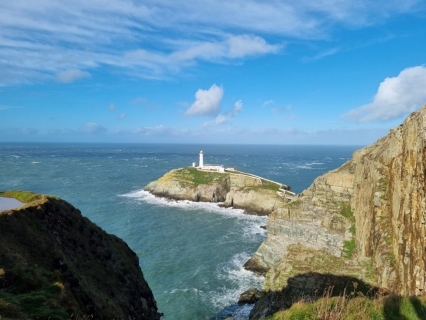
For the other species the over-arching issue is one of land management. Laura Kudelska, the RSPB Reserve Manager and our guide, is from a local farming tradition – and she needs to be. The fields where chough feed and skylarks nest have previously been farmed with little attention to the needs of wildlife. Now, carefully researched routines of grazing by 150 tough Hebridean sheep (and ‘wonky’ sheep – rescued because they lack a leg or are otherwise rejected) and a tough cattle herd of nine, ruled over by the smallest, a Dexter, achieve just the level of natural pasture that is required.
Meanwhile the gorse and heather moorland with careful control supports the silver-studded blue and of course its essential partner the black ant (spp). At the same time the 340ha reserve annually attracts tens of thousands of visitors, keen to see the birds and to explore the ancient hut circles. Inevitably there is an impact, but ways are found to minimise it where possible.
So South Stack is a reserve where staff and volunteers may need to shear a sheep, herd cattle and cut gorse as well as warmly welcoming and caring for visitors and providing advice and excellent viewing (and eating) facilities. An excellent day.
John Solbé FRSB
Language is not magic: A RSB and Bangor University Biological Society joint lecture
5 December 2019
Can we demystify our perception of language as a mysterious phenomenon of human brain operation? Language is often perceived as seemingly disconnected from other types of cognitive processes such as perception, emotion, attention, or decision making, however cognitive operations believed to be language-independent are implicitly modulated by language context and linguistic knowledge.
In his stimulating lecture Professor Guillaume Thierry enthusiastically communicated the results from four experiments using bilingual individuals and analysis based on the language in which they receive feedback; how they adjust their betting style; conceptualise motion events as more or less completed; look differentially more at second language words; and access metaphors that only exist in their native language.
In all cases, task requirements were deceptively simple, including a game of chance, detecting circle or square shapes and indicating time gaps of varied periods. Moreover, analyses concluded the bilingual brain manifested nonverbal cognitive modulations dependent upon contextual language information, of which is consistent with the idea that language representations are embodied in the human brain and providing support for the provocative idea that language and other facets of cognition are deeply, ineluctably, and unconsciously inter-twinned in the human mind.
The branch are very grateful to Professor Thierry for his time at this stimulating and thought-provoking event.
Marcus Jones, Bangor University student, and Michael Willis CBiol MRSB
Visit to Newborough Forest
5 October 2019
North Wales branch members met at Newborough Forest on Anglesey for a walk guided by Graham Williams of Natural Resources Wales.
The area is part of two Special Areas of Conservation (SACs), a National Nature Reserve and a Site of Special Scientific Interest, covering 2,303 hectare including shingle beach, sand dunes, salt marsh and dune slacks.
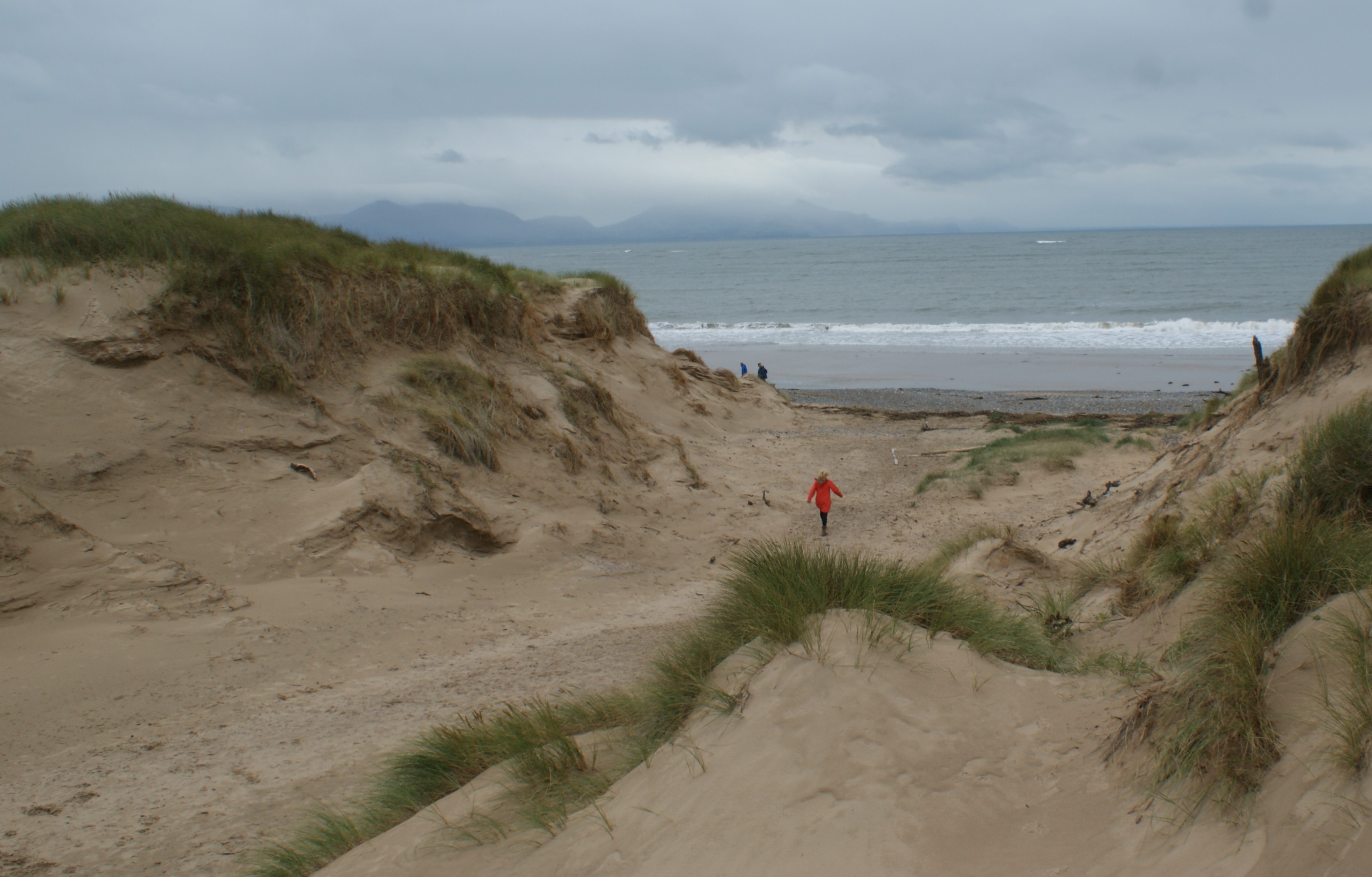
The 700ha Corsican pine forest was planted after WWII to stabilise the mobile dune system, to replenish stocks of pit-props after the mining effort during the war and to provide employment for men returning from active service.
The whole dune system was over 70% bare sand before the pine trees were planted, now only 2-3% of the area (> 0.5ha) is bare sand. Graham showed us the work that NRW are doing to manage the dunes for conservation.
Newborough forest is home to red squirrels so there is local resistance to any tree-felling but agreement was eventually achieved to fell small areas along the coast where the tress were wind damaged.
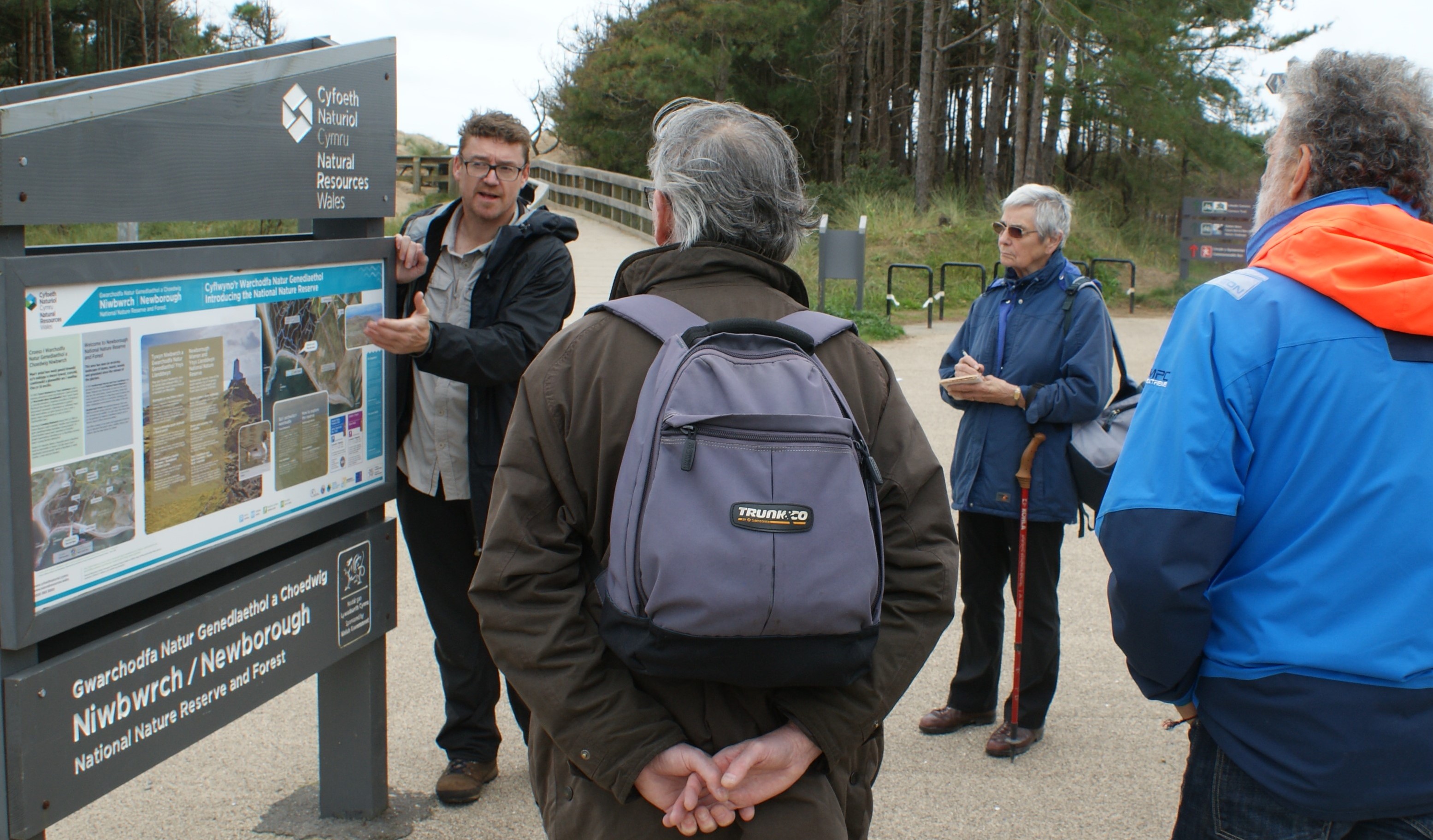
In one area the trees were felled and the roots left in situ, in another area tree roots were extracted. Artificial “notches” were cut through the dunes to the sea to allow the longshore wind to erode the sides of the notch, to push the sand inland and encourage the growth of marram grass, sand sedge, rest-harrow, lyme grass and sea spurge.
Sand lizards and rare beetles are seen in this area which is replacing the ruderal flora which had established on the stabilised and shaded dunes over the years. These experimental areas will provide the information NRW need to better manage the reserve to increase the biodiversity.
Holistically not only the flora and fauna but the geology, hydrology, geomorphology and the impact of climate change are factors which make management of this area complex.
Dr Rosemary Solbé FRSB
Christmas lecture and AGM
4 December 2018
Ahead of our AGM the Christmas lecture took place at the Bod Erw Hotel in St Asaph. Twenty members and friends heard the speaker, geneticist Professor Andrew Roberts, who talked about the genetics of roses and of his collaboration with the rose breeder David Austen.
He showed the diverse ploidy of roses in multiples of the haploid number seven. The ploidy is reflected in the distribution of rose types with polyploids to the north of the northern hemisphere, the ploidy decreasing towards the tropics where diploids predominate. He talked about the pentaploid Rosa canina, where the pollen has seven chromosomes and the ovules 28 (only seven of the chromosomes pair in nuclear division).
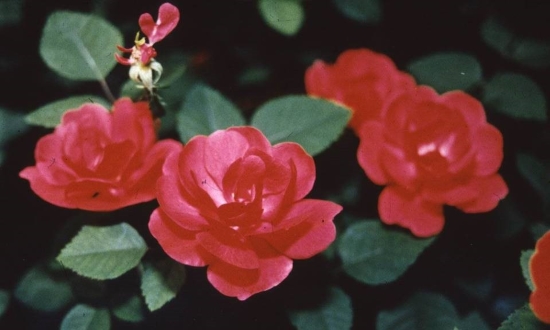
Apart from being attractive garden plants, roses are distilled for their oil, particularly in Bulgaria and Turkey, and the value of the world-wide production of rose oil is £125 million, from almost 20,000kg of rose petals.
Professor Roberts realised that roses are prone to a number of diseases such as mildew and black spot, but that brambles are not. After much work he and his team produced a bramble-rose somatic hybrid with a very attractive red flower but with leaves of altered appearance. It also had a strong scent of blackberries, which might have contributed to its fate: when the 36 carefully grown young plants were planted out all of them were eaten by rabbits. A sad tale to end a fascinating lecture.
Dr Rosemary Solbé FRSB
RSB at RSPB Conwy
13 October 2018
We couldn’t have chosen a wetter day for the North Wales branch visit to RSPB Conwy but stalwarts of the branch, along with members of the West Midlands branch and the Royal Geographic Society, still met for a day of talks and walks.
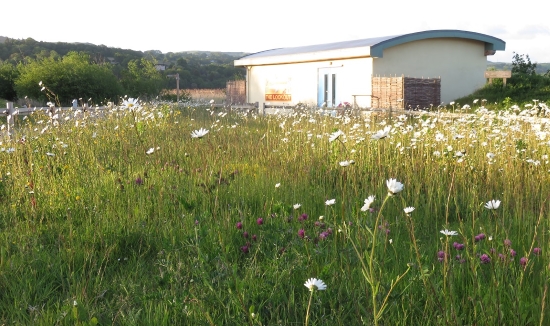
The RSPB Conwy Reserve is a 47 hectare man-made heap of contoured spoil (3 million cubic metres of it). The spoil comes from the trench cut to allow the installation of a 1060m tube tunnel below the Conwy Estuary 27 years ago. It is shaped into two lagoons, with islands and spits and 4km of paths including a track along the estuary itself.
Warden Tim Wallis gave a thorough description of the reserve. Apart from some minimal planting of trees early on, the whole site has been colonised naturally and is now a diverse area of nine distinct habitat types. Before the site was constructed (partly on salt marsh, partly on mis-used waste ground) the bird list was 46 species: it is now 236. There are 28 species of butterfly and hundreds of plant species, all having established themselves in the last few decades.
The rain eased and we walked through the reed beds and scrub to two of the hides. There were plenty of ducks, grebes, egrets and some fine greenshank (below) on view but it was too wet to walk by the estuary and see how the salt marsh is re-establishing itself and providing good feeding grounds.
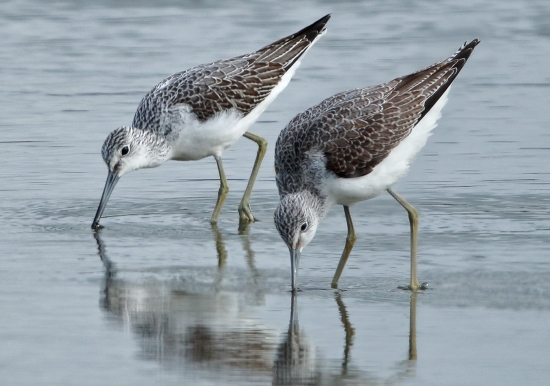
We returned to the warm for lunch followed by a description of the environmental improvements made - in terms of recycling, reducing waste and the use of water and electricity (129,000 kW saved in the last 10 years). A good discussion followed, with ideas offered for further improvements to the energy profile of the site.
The Reserve is visited by 85,000 people each year: 2,000 schoolchildren are introduced to the natural world and toddlers have an extensive sandpit to play in, overlooked by a very large but friendly dragon, in true Welsh fashion.
Professor John Solbé MBE FRSB
Christmases away from home: summer in the Sub-Antarctic
6 December 2017
Way down south in the Roaring Forties, Furious Fifties and Shrieking Sixties, sandwiched between Antarctica and the southern tips of Australasia, Africa and South America, lie a number of small, utterly remote, wind-blown but fascinating islands.
These are lands of bare volcanic rock, mosses, liverworts, marsh and bog, where trees are unknown and birds are plentiful. Sea mammals haul up on the beaches. Human signs (and graves) are those of early whalers or shipwrecked and marooned mariners. It sounds desolate, and it is – but life goes on among the mosses and even some flowering plants. Resources are scarce, but mosses are covered in blue-green algae which fix atmospheric nitrogen. In the cold, wet matrix below the green moss there is no decay – in fact the mosses from the frozen peat are not dead: they will sprout again if brought into the light and ‘warmth’.
Dr Shaun Russell, Director of Treborth Botanical Gardens, Bangor, gave us an intriguing picture of islands where the salt marshes sit on top of the cliffs and wandering albatross chicks sit out nine months on the nest before they can fly to the ocean.
For light relief, Shaun also described the white sands of the Falklands (ie not volcanic), the rich ecology of Tierra del Fuego and the many voyages of the Beagle charting these important waters.
The sight of a barograph where the pen had dived below the chart due to low, low pressure said it all. This is extreme territory in which to spend your Christmas.
Professor John Solbé FRSB
Visit to Coedydd Aber reserve
20 May 2017
Eleven members and guests of the North Wales branch met at the car park as the torrential rain of the journey gave way to welcome sunshine. The Coedydd Aber national nature reserve is a steep, part wooded valley on the north side of the Carneddau mountains of Snowdonia. Senior reserve manager Huw Green led a tour of the reserve, with frequent stops for explanatory of the biology and the reserves' management and restoration features.
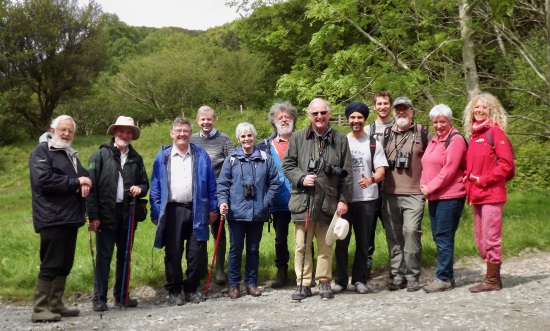
The reserve is an important Atlantic boreal oak woodland, cool, open and moist, sheltering many unique lichens, mosses and bryophytes. Huw showed members the varied microenvironments and their associated lichens, on the bark of ancient ash, and oak trees (oak bark gives a more acidic environment than basic ash, and a very different lichen profile).
The effects of human megafauna over time is shown by bronze age hut circles, stone walls of ancient field systems in the woodlands, more recent alder and hazel coppicing, and the 50 year old pine plantations up the valley sides – now being clear felled to allow regrowth and replanting with indigenous Welsh oak, birch and rowan.
The reserve is undergoing managed restoration of coppices, and re-opening the woodland to encourage indigenous biodiversity (even lichens and mosses need light for photosynthesis!) with managed grazing to limit ground vegetation competition.

The rather cool, though sunny day discouraged the local wild life, except for several dor beetles on the footpaths. However, buzzards floated on the updraughts, and a cuckoo was heard, and the scenery was stunning. Many thanks to reserve manager Huw Green for a grand day out.
Peter Thompson MRSB CBiol
Christmas Lecture on the common cold and flu
2 December 2016
Professor Ronald Eccles, of the Common Cold Research Centre at Cardiff, delivered an encyclopaedic review of current knowledge of the common cold and ‘flu’.
The common cold is the symptom of an infection by one of two hundred odd viral sereotypes of cold viruses. There are three main types of cold virus - 30% -50% are rhinoviruses, 10% - 15% are corona viruses and about 10% RSV (respiratory syncytial virus). Most of us get two to five colds a year, children about ten to twelve.
Unlike other human-specific viruses, for example polio, measles, or smallpox, where infection confers lifelong immunity, cold viruses can vary their surface antigens, allowing repeat infections to occur.
Influenza virus pandemics are set off by replication of a new variant of flu genotype, which evolves from crossover in multiple infected cells. The WHO continues to screen for the appearance of new viral sereotypes to update vaccine production.
Symptoms of cold and flu virus infections such as blocked sinuses, fever, aches, pains and coughs are all part of the human body’s fight back to the infection, mediated by prostaglandins and bradykinins. However, often infections do not cause any noticeable symptoms at all.
There are no known cures for cold and flu virus infections, except for alleviating the symptoms. However, the development of neuranimidase inhibitors, which block viral attachment of influenza viruses, are promising developments.
Nasal blockage and sinus swelling in a rhinovirus infection is annoying, and causes the temperature in nasal cavities to increase from the usual 28°C to 37°C. However, this limits rhinovirus replication, meaning decongestants can be counter productive.
This and many other anecdotes made for a most interesting and informative talk to which this report hardly does justice.
Peter Thompson MRSB CBiol
RSPB Conwy visit
12 November 2016
The RSPB reserve on the bank of the Afon Conwy in North Wales is a rather special site. It was created from the millions of tonnes of spoil removed from the bed of the estuary when the six box sections of the A55 undersea road tunnel were being installed in 1991.
This is not the only amazing engineering within sight of the reserve: across the water is Robert Stephenson’s 1849 cast-iron box railway bridge, alongside Thomas Telford’s 1826 road suspension bridge, in the shadow of Edward I’s mighty castle of 1285.
The North Wales Branch came, not only to walk around the reserve and view the wildlife in the two large lagoons, but also to learn how the environmental footprint of the reserve’s operation has been lessened in recent years. John and Rosie Solbé (both Fellows of the Society and volunteers at the reserve) have been part of a team reducing the consumption of electricity (by 87,000 kWh, from 2008 to 2015), reducing water use, organising the reduction, re-use and recycling of waste materials and limiting the use of hazardous products (mostly paints and cleaning products).
The day opened with a description of the site and its history by reserve manager Julian Hughes. From the early days of Portacabins the site now supports a coffee shop, visitor centre with education room, a comfortable look-out built of straw-bales (so no heating required), a children’s play area, dipping pond, board walks through the reed beds, covered hides and viewing screens, all set against the backdrop of the castle, the estuary and the mountains above the glaciated valley of the Conwy. More than 80,000 visitors are welcomed each year. The visitor centre now supports 44 photovoltaic panels; the coffee shop pre-heats its water with roof-mounted vacuum tubes and almost all the lights are LED. Waste water is treated in a three-phase septic tank and ‘polished’ in a newly installed reed-bed system.
Further measures have been applied throughout their offices, bathrooms and kitchens. John gave the results as graphs, kW and ££s and showed the relationship between environmental conditions and power and water consumption and even how the number and demographics of the visitors influence these figures.
After the talks the members had an informative guided tour with Julian, who covered not just the birds (230 species so far recorded, including great white egrets) but also some of the very rare moths and their food plants in this habitat, formed by machinery and colonised by nature.
Mergansers and the first goldeneye of the year performed on the lagoons where teal rested; snipe didn’t quite escape our notice; little egrets stalked the estuary and a flock of linnets did their bit to give us a delightful day.
Professor John Solbe MBE FRSB
Guest Lecture: The Microbiology of Oil Geochemistry
3 March 2016
Dr Steve Thompson, Partner Associated Petroleum Technologies UK, delivered a comprehensive review of petroleum formation and accumulation as part of the branch's guest lecture.
Bacteria and fungi act on accumulated sedimentary organic carbon over time to produce Keragen, from which petroleum is derived by heat and pressure at depths of 2700 to 4900 metres. The oil and gas formed migrate upwards by bouyancy until trapped under impermeable rock, ready for the oil drill.
The derived petroleum contains saturated alkanes, aromatic hydrocarbons, heterocyclic hydrocarbons, and huge polymeric asphaltenes. Isoprenoid alkanes are ubiquitous, derived from chlorophyll side chains of photosynthetic organisms and purple sulfur bacteria, highlighting the biological origins. High performance liquid chromatography of the petroleum gives a chromatogram of hydrocarbon species on which oil well development depends.
Archeobacteria can degrade petroleum in cool shallow reservoirs, but hot deep burial prevents this. Many oil discoveries can be rendered uneconomic because of microbial degradation of over half the oil fraction. Biodegradation of petroleum deposits and the released methane is probably the source of vast gas deposits in Siberia.
To conclude, Steve discussed the formation and stability of methane clathrates, where methane derived from microbial degradation forms complexes with ice. Global warming could raise ground temperatures in permafrost areas with sudden vast releases of methane as ice melts.
A sobering thought to end the talk.
Peter Thompson CBiol MRSB, branch secretary
Christmas lecture 2015: Why our conservation policies for freshwaters are spectacularly wrong
3 December 2015
Professor Brian Moss talked to the North Wales branch on inadequacies of current conservation policies. The problem, he said, was that, because the British landscape had been dissected for so long, sight had been lost that it was part of a continuous global system, on which major element cycles depended.
The Americans, in creating wilderness National Parks, had been more successful, but even they had made mistakes, in managing for human ends, rather than allowing self-regulation with an intact biota.
Professor Moss showed how global systems for carbon and oxygen cycling needed continuity and how the chemistry of the atmosphere, oceans and soils depended on biological processes that maintained the biosphere in a condition where liquid water was able to persist, and life could flourish.
Pristine land vegetation was parsimonious with nutrients, but various short-cuts had developed, including movements of nutrients by Pacific salmon among the oceans, rivers and surrounding forests, where scavengers like bears had important roles. In pristine African floodplain lakes, movements and dunging by large herbivores created a near pristine system, with turbid water and algal blooms that would be perceived, perhaps wrongly, as highly damaged in Europe.
There is increasing palaeolimnological evidence for large mammal herds and nutrient-rich conditions everywhere in the early Holocene. That has implications for how we now perceived reference states for lake restoration.
Conservation policy in Britain is dominated by parochial attitudes that essentially garden postage stamps of nature reserves, and ignore effects of catchment damage on freshwaters. It is faced with a much abused, polluted, engineered, manipulated and divided system. There is no way that a state even remotely answering that required by the Water Framework Directive (slightly different from no or negligible human influence) could easily be achieved under current conservation policies.
Government conservation agencies are less independent than ever before and have devised assessment schemes that allow boxes to be ticked for the pleasure of uncomprehending Government, rather than biodiversity to be genuinely conserved. Likewise, the Water Framework Directive has been betrayed by creation of liberal and politically motivated standards, with much propaganda but no net improvements over the past six years.
Moreover, like the backgrounds of virtually all world leaders, those of the Board members of both Government and Non-Government Agencies reflect a dominance of business, finance, law, politics, the military and hard engineering, with only marginal expertise in ecology. All of which might cause us to shrug our shoulders, for that is how the Establishment operates.
But with climate change, everything changes. Parochial national attitudes are counter productive and diversionary. Climate change is mutually linked with western overconsumption, with poverty, war and population growth in the developing world, and loss of three quarters of the biomes, which provide the best carbon stores.
Unless carbon emissions are reduced very rapidly, we must mop up the surplus carbon of over 4 gigatonnes, accumulating in the atmosphere each year, with new and replacement stores.
Temperature will not begin to fall until emissions are annually matched by storages. The scale of the problem is that about one-third of current world agricultural land would need to be rewilded to functioning biome, with immense implications for human societies.
Perhaps we will not succeed and will face catastrophic consequences, but we should heed what W H Auden wrote in 1947: We would rather be ruined than saved; we would rather die in our dread than climb the cross of the moment and let our illusions die.
Professor John Solbe MBE FRSB
Erddig Gardens
10 October 2015
John Baker, a valued volunteer at Erddig, arranged this visit and talk from head gardener Glyn Smith.
Seven members and guests met on a sunny autumnal day and were led to a vast display of apple varieties ‐ 148 of the orchards collection. The apple crop has already been picked and was ripening in empty greenhouses ready for sale.
Glyn gave a brief history of the origins of domesticated apples from the European crab apples (Malus sylvestris) to the modern day sweet apples (Malus pumila spp). Apple varieties of were long thought to be hybrids of the two, but recent studies of DNA and history traces M. pumila type apples back to the Tien San region of Kazakstan, coming along the Silk Road to Europe.
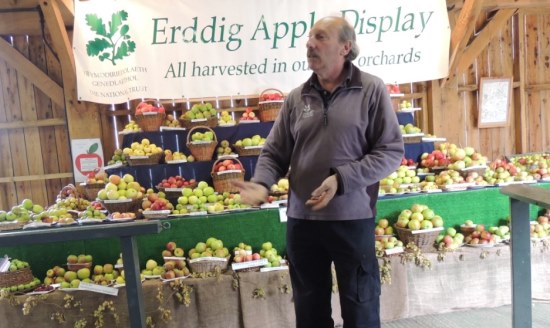
Though the Erddig apple collection holds 148 distinct varieties, requests for identification of apples is still a bit of an art, rather than a science. DNA markers will come. Apples are hermaphrodites, but self incompatible to their own pollen, hence the requirement of cross pollination by other pollination groups determined by overlapping flowering periods. But, as Glyn remarked, you could hold early flowers in the fridge and get fertilisation.
Human selection and crossing of apple varieties have led to the 'sweetest' apple Golden Delicious. As well as supermarket varieties bred for rough handling and colour uniformity - at the cost of taste!
The apple taste is influenced by the presence of tannins from almost nothing in Golden Delicious to the almost inedible cider apple varieties. Crossing apple varieties produces incredibly varied offspring ‐ hence selected varieties are and have been maintained by grafting for a 1000 years or more of DNA replication.
Glyn finished the visit by giving a tour of the garden. He discussed its history, the future of funding and teaching/training of future horticulturists. Members and guests finish an enjoyable day with an excellent lunch in the Trust's restaurant.
Peter Thompson MRSB CBiol
The Return of the Beaver
Prosiect Afoncod Cymru
4 December 2014
This was the subject of a talk by Adrian Lloyd Jones of the North Wales Wildlife Trust to members and friends of the North Wales branch at St Asaph in early December. The lecture was followed by the branch AGM and an excellent buffet at the Bod Erw Hotel.
Adrian has led the project on returning the beaver to Wales since 2005, a period in which he has examined the habits of the European beaver Castor fiber in parts of mainland Europe where beavers have lived for decades.
In Wales beavers were already very rare in the time of Giraldus Cambrensis (1188), hunted for their valuable pelt, their meat and other bits of their anatomy which were thought to have medicinal properties! In the case of their castor sacs this may have been real, since beavers eat willow and castoreum contains salicin but in the case of their testicles the effects were a myth.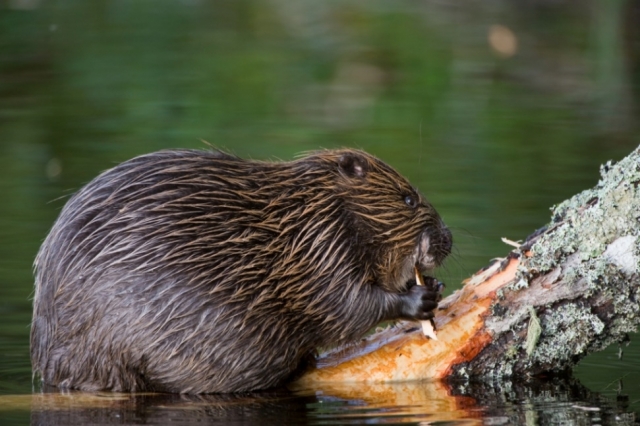 Credit: Allard Martinius
Credit: Allard Martinius
Canadian beaver and European beaver cannot interbreed (distinctly different numbers of chromosomes). In the UK they can be found in zoos, in secure enclosures and also in the wild.
Looking at the ecology and habitat of beaver on the European mainland provides clues on how beaver might respond to and affect UK habitats. They don't eat fish (!); they do like aspen; they are not keen on conifers; they eat bark when they need to; they do burrow as well as build lodges; they live together as two generations and when a third generation arrives the second must leave.
They defend their territory against intruding beaver and their fights can be serious! Typically they take charge of 3km of shoreline and only a very small fraction of their lives is spent more than 20 metres from the water's edge.
Beaver make dams up to about one metre in height. They fell trees for this purpose and open up the riparian canopy, increasing the variation in age-class structure of the trees. The response of the nibbled or felled trees is to put out suckers so they increase young growth. The dams provide an underwater entrance to their lodges.
Dams can affect water quality and the hydrograph because they act as silt and nutrient traps and their structure as well as resultant ponds provide additional wildlife habitat. Beaver are considered as keystone species providing benefits for others. It is said that the biomass of fish in a beaver area is as much as 80 times greater than elsewhere. When beaver abandon a lodge, otters can move in.
Beaver can damage field crops but this tends to occur where the riparian buffer zone is very narrow. Their burrows can collapse and they can drill through dykes. Control measures include, amongst other things, electric fencing, trapping (using apples as bait) and removing animals but it has been estimated that the benefit of beaver outweighs the cost of control measures 100-fold.
In Wales there are excellent locations for planned experimental releases of beaver but sites are now sought where problems are more likely to occur than in the more isolated upland valleys originally proposed. This will allow investigation of their impacts on aquatic features such as salmon, and provide experience in addressing negative impacts. Watch this space!
Professor John Solbé MBE CBiol FSB
The Hitchhiker's Guide to Urban Forestry
14 March 2014
This was the intriguing title of Tim Hall's talk in Bangor University to a lecture theatre packed with students, staff, members and friends the branch. David Urry, regional coordinator at the Society, began proceedings by introducing the role and benefits of the Society.
Worldwide, 50% of people now live in cities and the figure is even higher (80%) in the UK. Cities include trees to a greater or lesser extent. Trees in such close proximity to city dwellers are termed urban forests. Are trees beneficial? How? Is there a financial, social, psychological or environmental gain?
Tim, from the Woodland Trust for Scotland addressed these questions using examples from around the world. Consider the effect of a row of deciduous trees in a street of typically mixed use. In summer the trees shade the buildings and pavements, and thus lessening the need for air-conditioning. Mature tree can act as an evaporative cooling system, evapo-transpiring 450 litres of water each day. In winter the leaves have fallen so the bare branches allow warmth and light through and thus reduce the amount of heating required, while also lessening the wind-chill factor on the structures and still absorbing some of the traffic noise.
Trees scour particulates and even some undesirable gases from the urban atmosphere. In Chicago it is calculated that trees remove 10.8 tonnes of particulate pollutants each day. They lessen the impact of rainfall with its effects on soil and sediment run-off and retain moisture in their root systems.
Yes, there can be problems when trees are not managed correctly: roots can undermine buildings or disrupt the many services which are now routed below our pavements. Dead branches can fall or violent winds fell even the strongest trees. But think of the advantages – the pleasant walk to work or the shops under a canopy of leaves; the great benefit of parkland as originally conceived by the Victorians; the ecosystem diversity trees offer; the health benefits (apparently there is an inverse correlation between childhood asthma and urban tree density).
Tim's hitchhiking was a success, without recourse to his towel or the number 42.
Professor John Solbé MBE CBiol FSB
Fungal Foray In Treborth
5 October 2013
Members joined students from Prifysgol Bangor on a fungal foray to Treborth, the University's botanical garden. The autumn colours had hardly developed in this Indian summer but the fungi made up for this with an amazing array of hues from blush pink, through orange and brown to white, deep violet and black.
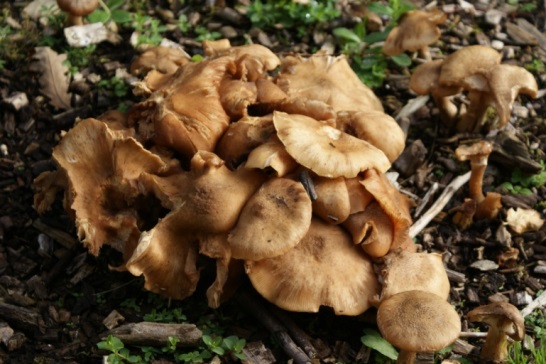 Our knowledgeable guide Nigel Brown explained some of the intricacy of fungi, the challenges they presented to the taxonomist, their many strategies for reproduction and survival, their chemical complexity and the delights and affronts they could impose on our senses.
Our knowledgeable guide Nigel Brown explained some of the intricacy of fungi, the challenges they presented to the taxonomist, their many strategies for reproduction and survival, their chemical complexity and the delights and affronts they could impose on our senses.
The most deadly (to plants) honey fungus Armillaria mellea was in profusion with its fruiting bodies lined up along the lawns. This was a puzzling. The fungus is a root parasite but it made its way straight across the grass and not around a tree. Perhaps its black rhizomorphs were following a straight root run from a distant tree.
We learned of the various forms of simple folds, laminate gills, spines or complex pores from which the spores were released. The most minute deviation from the vertical would mean spores hit the sticky sides of the gills and not get released.
Red Admiral butterflies were also in abundance, we saw them feeding on fallen, fermenting apples and becoming intoxicated and less cautious as a result. The afternoon ended with an inspection of the massed collection of the two dozen foragers. Fungi are so varied and so complex that we may well have found new species for the site.
Professor John Solbé MBE CBiol FSB
Exploring an explosives factory
11 May 2013
Near Porthmadog in North Wales lies a rather unusual (and potentially exciting) nature reserve: an abandoned site of nitroglycerine manufacture. The process involved mixing glycol plus nitric acid and sulphuric acid with glycerine (carefully). For safety reasons the site occupied a wide area (28ha) with its three valleys each carrying out a distinct process. Woodland provided some degree of insulation from explosions as did using buildings whose roofs were designed to blow off in the event of problems. In the early days, mixing was done manually and the temperature was crucial; too cool and the reaction did not occur, too warm and it exploded. The worker whose job it was to stir and maintain the temperature was provided with a one-legged stool so if he nodded off he also fell off and woke in time to monitor the reaction!
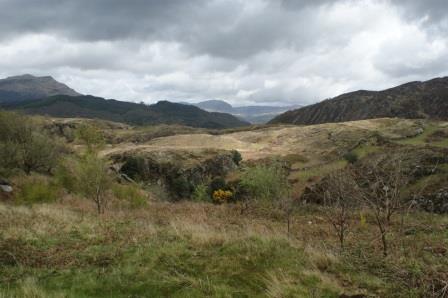
The site opened in 1865 and was completely destroyed by a massive explosion in 1915. After serving the armaments industry in both World Wars (5,000 tonnes of military explosive and 17 million grenades safely made in WWII) the factory continued to operate making very effective and safe detonators for the mining industry until 1995. Since then (and a cleansing process using fire to mop up any remaining explosive contamination) the site has been left almost in peace having been handed over to the North Wales Wildlife Trust in 1998. It now offers a haven for wildlife such as nightjars, lesser horseshoe bats and a large number of moth species.
On a wet and windy morning in May ten members and friends of the North Wales branch explored the site under the guidance of Mike Willis (whose most important instruction was not to touch anything that might explode)! To the contrasting calls of cuckoos, willow warblers and ravens we climbed up through sessile oaks, birches and willows with native bluebells and wild strawberries underfoot, past ponds for cooling and for purifying the products and derelict buildings including safety shelters, now inhabited by bats, to the nightjar territory of mixed heathland. Up on this height there were extensive views all round and the impressive sight of a two tonne ballistic pendulum, into whose maw was positioned a cannon loaded with a test charge of explosive. The distance the pendulum swung when the cannon was fired gave a measurement of the strength of the batch tested.
Our discussions of the natural history and ecology were concluded in warmer conditions over a pub lunch.
Professor John Solbé MBE CBiol FSB



